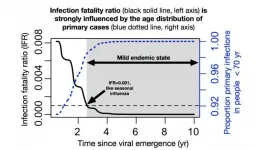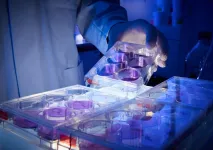(Press-News.org) Family courts are misunderstanding and misusing research around how children form close relationships with their caregivers, say an international group of experts.
Seventy experts from across the globe argue that widespread misunderstandings around attachment research have hampered its accurate implementation, with potentially negative consequences for decisions in family courts.
In response, they have published an international consensus statement in Attachment & Human Development that aims "to counter misinformation and help steer family court applications of attachment theory in a supportive, evidence-based direction on matters related to child protection and custody decisions".
In the statement, the group sets out three principles from attachment research which they say should guide decision-making: the child's need for familiar, non-abusive caregivers; the value of continuity of good-enough care; and the benefits of networks of familiar relationships.
Attachment research investigates the strong affectional bonds - 'attachments' - that individuals form to others in order to achieve comfort and protection. Children are born with a predisposition to develop these bonds with 'attachment figures' in their lives. This often includes the child's parents, but many children develop attachment relationships with additional caregivers, such as grandparents. Children wish to turn to their attachment figures when upset.
The quality of an attachment relationship - how readily a child will turn to their caregiver and accept comfort - is indicated by behaviour suggestive of whether or not they expect their attachment figures to respond sensitively to their signals in times of need. Indeed, the most important predictor of children's attachment quality is caregiver 'sensitivity': the ability to perceive, interpret and respond in a timely manner and appropriately to children's signals.
Attachment research is applied in many settings, including in family court decision-making regarding child custody and child protection. Court practice needs to follow the best interests of the child, but this can be difficult to determine. There is an increasing focus on the interactions and relationships between children and their caregivers, which in turn has led to interest in using attachment theory and measures to help guide decision-making.
Dr Robbie Duschinsky from the University of Cambridge, said: "The decisions reached by family courts can have a major impact on a child's life, but as we've seen, these decisions may be based on incorrect understanding and assumptions. By outlining potential issues and presenting principles to guide the decision-making process, we hope to better inform and hence empower courts to act in a child's best interests."
One example is the mistaken assumption that attachment quality equals relationship quality, and that it is possible to judge attachment quality by looking at isolated behaviours. In fact, there are many other important aspects of child-caregiver relationships, such as play, supervision and teaching, and specific behaviours such as crying can depend on largely constitutional factors such as temperament.
There are also misunderstandings regarding the importance of developing attachment to one particular caregiver rather than to more than one, with the theory misinterpreted as placing an emphasis on one 'psychological parent', typically the mother. In this line of reasoning, it is often assumed that an attachment relationship with one person is at the expense of other attachment relationships, and that best-interest decisions should maximise the likelihood of secure attachment with one primary caregiver. However, children can develop and maintain secure attachment relationships to multiple caregivers simultaneously, and a network of attachment relationships may well constitute a protective factor in child development.
In other cases, attachment theory has been held to categorically prescribe joint physical custody, with equal time allocation regardless of child age, including overnights and transitions between family homes every day or every other day. Yet, there is a notable scarcity of empirical research on attachment in relation to child custody, time allocation, and overnight arrangements.
Dr Tommie Forslund from Stockholm University said: "Misunderstandings can have important consequences for children and their caregivers. In some cases, they can lead to an ill-informed dismissal of the relevance of attachment by court professionals or, conversely, to the overuse of attachment ideas and measures, with practice unmoored from evidence.
"We need to make sure that courts are aware of the limits of current understanding as well as the nuances of attachment theory and research before seeking to apply it to their decision-making."
The researchers have also advised caution in using assessments of attachment quality in the family courts.
Professor Pehr Granqvist from Stockholm University added: "Courts need to bear in mind that while assessments of attachment quality may be suitable for helping target supportive interventions, there are different opinions even among those of us who specialise in attachment research regarding the potential usefulness of these assessments when it comes to decision-making regarding child protection.
"Validated in group-level research, attachment measures have insufficient precision for individual level prediction. If used at all, assessments of attachment quality should never be used in isolation but only as part of a larger assessment battery that assigns more weight to direct assessments of caregiving behaviour. Importantly, attachment assessments must only be used by formally trained observers who follow standardised protocols."
The experts propose three fundamental principles, based on more than half a century of research, which they argue can be used as a basis for court practitioners:
The need for familiar, non-abusive caregivers - For child protection practice, for example, this implies that all non-abusive and non-neglecting family-based care is likely to be better than institutional care.
The value of continuity of good-enough care - 'Good-enough' care signifies an adequate level of meeting the child's needs over time. The group urges family courts to examine and support caregivers' abilities to provide 'good-enough' caregiving, rather than placing children in out-of-home custody with the hope of 'optimal' care. Major separations from caregivers constitute risk factors in child development that should be prevented whenever possible.
The benefits of networks of attachment relationships - Decision-making concerning child custody should assign weight to supporting children's ability to develop and maintain attachment relationships with both their caregivers, except when there is threat to the child's welfare and safety or one of the parents wants to 'opt out'.
INFORMATION:
Reference
Attachment Goes to Court: Child Protection and Custody Issues. Attachment & Human Development; 11 Jan 2021; DOI: 10.1080/14616734.2020.1840762
Philadelphia, January 12, 2021 - A special issue of the Journal of the American College of Radiology (JACR), published by Elsevier, challenges conventional wisdom across the imaging community. This collection of articles, the "Provocative Issue," presents extreme opinions on pressing issues confronting radiologists with the deliberate aim of sparking positive dialog and debate that will lead to innovative solutions to improve patient care and imaging-related outcomes.
The issue is guest-edited by:
Caroline Chung, MD, MSc, Director of Advanced ...
ATLANTA - JANUARY 12, 2021 - Overall cancer death rates in the United States dropped continuously from 1991 through 2018 for a total decrease of 31%, including a 2.4% decline from 2017 to 2018. The news comes from the American Cancer Society's annual Cancer Statistics, 2021 article, appearing in CA: A Cancer Journal for Clinicians, and its consumer version, Cancer Facts & Figures 2021. This year marks the American Cancer Society's 70th anniversary of reporting this data to inform the nation's fight against cancer.
The report estimates that in the U.S. in 2021, almost 1.9 million (1,898,160) new cancer cases will be diagnosed and 608,570 Americans will die from cancer. ...
Remarkably well-preserved fossils are helping scientists unravel a mystery about the origins of early animals that puzzled Charles Darwin.
Analysis of the 547 million-year-old remains has enabled researchers to trace the ancestry of some of the world's earliest animals further back than ever before.
Their study has uncovered the first known link between animals that evolved during the so-called Cambrian Explosion some 540 million-years-ago and one of their early ancestors.
Until recently, little was known about the origins of animals that evolved during the Cambrian event because of a lack of well-preserved fossil evidence.
The mysterious origins of animals that evolved at this time - when the diversity ...
Core technology includes promising bivalent single-domain antibodies simultaneously targeting two surface structures of the viral spike protein.
Lead candidates DIOS-202 and DIOS-203 are engineered for high potency and their potential to avoid the emergence of escape mutants.
DIOS-202 and DIOS-203 entered into accelerated development to initiate clinical studies later this year.
BONN, Germany, January 12, 2021 - DiosCURE SE announced a publication in Science describing its core technology of multivalent single-chain antibodies with a unique molecular mode-of-action to inactivate ...
While most people are able to eat a normal diet, many of those managing distinct nutritional requirements related to a disease or health condition rely on medical foods. Medical foods help patients meet their nutritional needs, often improving nutritional and health outcomes and quality of life. A recent publication in Current Developments in Nutrition, titled "Medical Foods: Science, Regulation, and Practical Aspects. Summary of a Workshop," shares the historical and regulatory context of medical foods and perspectives on their role in the future.
Medical foods help patients manage their nutritional needs, yet it can be very difficult for patients to have access to them. In August 2019, the Healthcare Nutrition Council (HNC), in partnership with the American Society ...
What is the endgame for SARS-CoV-2, the virus that is causing worldwide devastation? If it becomes endemic -- circulating in the general population -- and most people are exposed in childhood, SARS-CoV-2 may join the ranks of mild cold-causing coronaviruses that currently circulate in humans, according to a model developed by Emory and Penn State scientists.
The model, published January 12 in Science, draws upon studies of the four common cold coronaviruses and SARS-CoV-1. For those viruses, the term "herd immunity" is incomplete and possibly misleading, says ...
Antibodies are an important weapon in the immune system's defense against infections. They bind to the surface structures of bacteria or viruses and prevent their replication. One strategy in the fight against disease is therefore to produce effective antibodies in large quantities and inject them into the patients. The outgoing US President Donald Trump probably owes his rapid recovery to this method. However, the antibodies used to treat him have a complex structure, do not penetrate very deeply into the tissue and may cause unwanted complications. Moreover, producing antibodies is difficult and time-consuming. They are therefore probably not suitable for widespread use.
Mass production in yeast or bacteria
"We focus on another group of molecules, the nanobodies," ...
Researchers at Karolinska Institutet in Sweden have developed, in collaboration with researchers in Germany and the U.S., new small antibodies, also known as nanobodies, which prevent the SARS-CoV-2 coronavirus from entering human cells. The research study, published in Science, shows that a combined nanobody had a particularly good effect - even if the virus mutated. According to the researchers, the nanobodies have the potential to be developed into a treatment for COVID-19.
Specific proteins, spike proteins, on the surface of the SARS-CoV-2 coronavirus help the virus infect host cells. Therefore, antibodies that block the spike proteins and prevent them from binding to the cell can be a way to stop infection.
From the perspective ...
What will the SARS-CoV-2 outbreak look like ten years from now as it passes from pandemic to endemic, maintained at a constant baseline level in populations without being fueled by outside infections? Data from four endemic human coronaviruses, which circulate globally and cause only mild symptoms, may hold some answers, say Jennie Lavine and colleagues. Their analysis of the immunological and epidemiological data for these viruses helped them develop a model to predict the trajectory of SARS-CoV-2 as it becomes endemic. Most importantly, the authors say, their model incorporates distinct components of immunological protection--susceptibility to reinfection, weakening of the disease after reinfection, and transmissibility of the virus after reinfection--that each wane differently. Lavine ...
An immunization strategy tested in mice protects against infection from SARS-CoV-2, as well as from potentially emerging animal coronaviruses, researchers say. The approach could be "used as described or easily adapted" to provide defense against newly discovered zoonotic coronaviruses. In the last 20 years, three betacoronaviruses have caused devastating disease in humans. The global pandemic caused by the latest such virus, SARS-CoV-2, highlights the need to protect against other strains that could present a threat to humans, possibly through a pan-coronavirus vaccine. To support related efforts, ...




